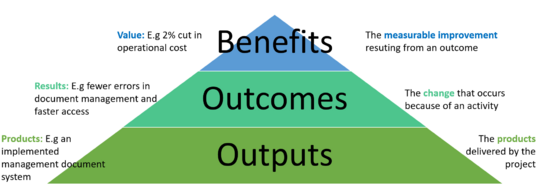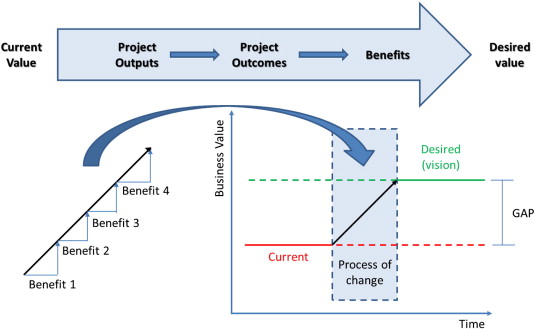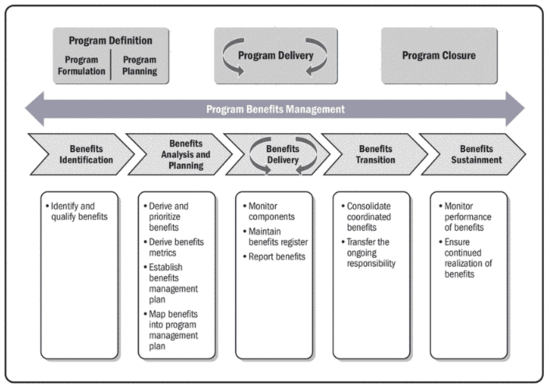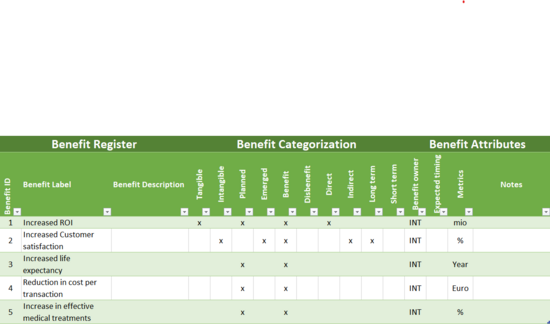Benefit Realization Management
Contents |
Executive Summary
Benefit Realization Management (BRM) is a critical discipline that plays a vital role in ensuring organizations derive maximum value from their projects and programs by focusing on the identification, planning, execution, and review of benefits throughout their lifecycle. It is more crucial than ever for firms to invest in programs that provide value and help organizations achieve their strategic goals in today's competitive business environment. By coordinating projects and programs with strategic goals and turning these goals into quantifiable and reachable outcomes, BRM offers a disciplined framework to manage this process.
BRM's main goal is to guarantee that a program's targeted objectives and outcomes are accurately aligned with benefits that can be controlled and monitored, increasing return on investment (ROI) and promoting continuous improvementt. This entails not just recognizing prospective advantages but also organizing and carrying out actions to help them operationalize. It also entails comparing actual benefits to anticipated benefits in order to assess success and guide future actions.[1] By adopting BRM practices, organizations can improve decision-making, foster stakeholder engagement, and optimize resource allocation, ensuring that projects and programs deliver the expected value. Furthermore, BRM helps organizations to better manage risks and uncertainties associated with projects and programs, increasing the likelihood of success and promoting a culture of learning and growth.
This article provides an in-depth exploration of the concept of Benefit Realization Management and its importance in the context of program management. It delves into the various aspects of BRM, including the process of operationalizing benefits through Benefit Realisation Management Framework, techniques and tools used and guidelines when practicing Benefit Realization Management.
What is Benefit Realisation Management
The purpose of Benefit Realization Management (BRM) is to ensure that the program's outcomes align with the business objectives and that the expected benefits are achieved. Program management is concerned with managing multiple related projects that are intended to deliver a common goal or set of goals. The purpose of BRM in program management is to ensure that the benefits of each project are integrated and aligned with the overall program objectives. This involves identifying, planning, delivery, transition and benefits sustainment of each project is expected to deliver, and then ensuring that they are integrated into the program's overall benefits realization plan.[2]

Relationship between Benefits, Outcomes and Components
Benefits, outcomes, and outputs are fundamental terms in project management, often used to define various aspects of objectives and results. Understanding the distinctions between benefits, outcomes, and outputs can sometimes be challenging due to their interconnected nature. Therefore, this section aims to provide a clearer understanding of these concepts by elaborating on each term in a way that is easy to grasp.[3]
Benefits: These are the perceived positive impacts or gains resulting from a project, which could be both tangible (quantifiable in monetary terms) and intangible (harder to measure but equally important, such as improved reputation). Benefits are the reason why projects are initiated, and they align with strategic goals of the organization.
Outcomes: Outcomes refer to the effects or changes brought about by the completion of the project, often seen in the behavior, activities, or conditions of the project's stakeholders. They are the intermediate states between the project's outputs and the ultimate benefits. Outcomes can be intended (expected results) or unintended (unexpected results), and positive (beneficial results) or negative (harmful results).
Outputs: These are the tangible products, services, or results that a project produces. Outputs are the immediate and measurable results at the end of a project or a project phase. For instance, in a project to build a new software application, the software itself is the output.
Why Benefit Realisation Management

Effective business strategies are crucial as they deliver stakeholder value, forming the basis of an organization's long-term cash generation or the ability to provide valuable public services. By setting measurable strategic objectives, these strategies establish targets for future value. The value gap, illustrated in Figure 2 defined as the difference between the present situation and the target future scenario, is then filled by strategic initiatives. These initiatives foster new capabilities through project outputs. Projects, unique organizational efforts, aim to bring about positive, defined changes in business processes to meet these strategic objectives. The strategic improvements brought about by these projects are known as 'benefits'. These benefits enhance business value from various perspectives such as shareholders, customers, suppliers, or society at large.
The concept of benefits realization management, therefore, is central to this process. It is essentially the process of organizing and managing projects, programs, and portfolios in such a way that potential benefits are defined, maximized, and sustained. It not only helps organizations align projects and programs with strategic objectives but also ensures that projects and programs deliver the desired outcomes, thus filling the value gap. In other words, the 'why' behind benefit realization management is its pivotal role in translating business strategies into results, ensuring the success of the business strategy, and ultimately enhancing stakeholder value.
Benefit Realization Management Framework
From the standpoint of program management, BRM offers a framework for managing the program's benefits, including benefit identification and prioritization, creation of a benefits realization strategy, and tracking and evaluating progress. BRM gives program managers a means to assess if their programs are accomplishing their intended objectives. Program managers can decide if a program has been successful or not by comparing the actual outcomes to its anticipated benefits. To maximize the program's effectiveness and value, this information can be used to make improvements to its strategy, tactics, and execution. Overall, the purpose of BRM from a program management perspective is to ensure that the program delivers the intended benefits to the organization. By using a structured approach to identifying, planning, and monitoring the benefits of the program, program managers can ensure that the program is aligned with the business objectives and delivers value to the organization. Furthermore it assist the program stakeholders to focus on the outcomes and benefits to provided by the various activities and components conducted during the programs durations. To allow for this it is essential that the program manager employs Benefit Realization Management to:[1]
- Identify and assess the value and impact of program benefits
- Monitor the interdependencies among the outputs being delivered by the various components within the program and how outputs contribute overall to the program's benefits
- Analyze the potential impact of planned program changes on the expected benefits and outcomes
- Align the expected benefits with the organization's goals and objectives
- Assign responsibilities and accountability for the realization of benefits provided by the program and ensure that the benefits can be sustained.

Benefit Identification
The first phase within the program benefit realization management framework is where you as an organization identify the strategic goals. Initiatives based on the strategic goals of the company are identified and a program initiated to steer the organization in a more desired direction. In general, this phase consists of scoping activities. Activities that are included Benefit identification include defining the objectives and critical success factors for the program, identifying and quantifying business benefits.
Benefit register
The program's projected benefits are gathered and listed in the benefits register, which is also used to track and communicate benefit delivery over the course of the program. The organization's strategic strategy, the program business case, and other relevant program objectives are used to construct the benefits register during the benefits identification phase. The register is then discussed with important stakeholders in order to create the best performance metrics for each benefit. The program benefits register is updated after the identification of the key performance indicators, and the associated quantitative and qualitative measurements are defined and elaborated in the following phase. This is a repository in which benefit profiles are recorded. At various organizational levels, the register may be used in multiple ways to suit the demands of the organization. For instance, a program might have a management repository for all of its benefits. The benefits register may take many different shapes, but it normally contains:[1]
- List of planned benefits
- Mapping of the planned benefits to the program components, as reflected in the program roadmap
- Description of how each benefit will be measured
- Key performance indicators and thresholds for evaluating their achievement
- Risk assessment and probability for achieving the benefit
- Status or progress indicator for each benefit;
- Target dates and milestones for benefits achievement
- Person, group, or organization responsible for delivering each benefit
- Establishment of processes for measuring progress against the benefits plan
- Tracking and communications processes necessary to record program progress and report to stakeholders.

Benefits analysis and Planning
Establishing the program's benefits management strategy as well as creating the metrics and framework for tracking and managing the program's components and measuring its benefits are the goals of the benefits analysis and planning phase. Benefits analysis and planning tasks include the following:[1]
- Establishing the benefits management plan that will guide the work through the remainder of the program
- Defining and prioritizing program components and their interdependencies
- Defining the key performance indicators (KPI) and associated quantitative measures required to effectively monitor the delivery of program benefits
- Establishing the performance baseline for the program and communicating program performance metrics to the key stakeholders
- Updating positive and negative risks to benefits as more information becomes known.
Where in the benefit identification phase it was asked what should be changed and measured now it is time to ask how. In the Benefit analysis it is suggested to formulate a benefits management plan. This is to make actions in the next phase benefits delivery tangible. It allows prioritization of components and efficient execution of components.
Benefits management plan
The benefits management plan is the officially recorded description that outlines the procedures for generating, enhancing, and preserving the benefits yielded by a project or program. This plan thoroughly records the steps necessary for attaining the intended benefits of the program. It lays out the expected timing and methods of delivering benefits to the organization and details the systems that should be in place to guarantee that benefits are fully reaped over time. The benefits management plan serves as the foundational document directing the delivery of benefits throughout the program's execution. Additionally, it pinpoints the corresponding activities, processes, and systems required for the change sparked by the realization of benefits; the necessary modifications to existing processes and systems; and the manner and timing of the transition into an operational state. The benefits management plan should:[1]
- Define each benefit and associated assumptions and determine how each benefit will be achieved
- Link components outputs to the planned program outcomes
- Define the metrics (including key performance indicators) and procedures to measure benefits
- Define roles and responsibilities required to manage the benefits
- Define how the resulting benefits and capabilities will be transitioned into an operational state to achieve benefits
- Define how the resulting capabilities will be transitioned to the individuals, groups, or organizations responsible for sustaining the benefits
- Provide a process for managing the overall benefits management effort.
During benefits analysis and planning, the benefits register, which was started during benefits identification, is updated. On the basis of the program roadmap, program benefits are currently mapped to the program components. Following a review of the benefits register by the relevant parties, key performance indicators and other metrics that will be used to gauge program success are defined and approved.
Benefits Delivery
The benefits delivery phase is aimed at making certain that the program yields the anticipated benefits, as outlined in the benefits management plan. Throughout the program's execution, risks impacting benefits may come to fruition, may require modification, or may become outdated; also, fresh and revised risks should be incorporated into the benefits register along with their associated benefits. The components of benefits delivery consist of: [1]
- Monitoring the organizational environment (including internal and external factors), program objectives, and benefits realization to ensure that the program remains aligned with the organization’s strategic objectives
- Initiating, performing, transitioning, and closing components, and managing the interdependencies among them
- Evaluating opportunities and threats affecting benefits, including updating the benefits register for new opportunities and risks affecting benefits, and updating realized or obsolete risks affecting benefits
- Evaluating key performance indicators related to program financials, compliance, quality, safety, and stakeholder satisfaction in order to monitor the delivery of benefits
- Recording program progress in the benefits register and reporting to key stakeholders as directed in the program communications management plan.
The benefits delivery phase guarantees that there is a pre-determined set of reports or metrics provided to the program management office, program steering committee, program sponsors, and other program stakeholders. By regularly keeping track of and reporting on benefits metrics, stakeholders can evaluate the overall state of the program and initiate suitable actions to ensure successful benefits delivery. [1]
Benefits management is an iterative process. Particularly, benefits analysis and planning, as well as benefits delivery, maintain a cyclic relationship. Benefits analysis and planning may be perpetually revisited as the situation change. Corrective measures might be necessary in reaction to insights obtained from monitoring the organizational environment. Components might need adjustment to keep the expected program results aligned with the organization’s strategic objectives. Corrective measures might also be necessary as a result of evaluating program risks and key performance indicators. Modifications may be required in components due to performance related to program financials, compliance, quality, safety, and/or stakeholder satisfaction. These corrective measures might necessitate that program components be introduced, altered, or discontinued during the benefits delivery phase.
Benefits Transition
Benefits transition, a critical aspect of project management, ensures that the transition scope is outlined, stakeholders are identified and involved, benefits are measured with sustainment plans, and transition is executed. It forms only part of the entire transition process, with the receiving organization being responsible for incorporating the product or service into their operations. There might be multiple transition events during the program lifecycle.
Benefits can be realized even before the program concludes and they often continue well beyond program completion. The transition of benefits could follow the closure of individual program components, or the overall program itself, depending on whether incremental benefits are identified.
Benefits are quantified for measuring their realization over time, and this might extend well beyond the active program phase. It's essential to compare the resulting benefits with the intended ones at the program's end. Finally, benefits transition activities ensure that program outputs meet criteria, integrate successfully, and contribute to the overall program benefits. Activities related to benefits transition guarantee that individual program component outcomes or outputs fulfill acceptance criteria, are adequately concluded or incorporated into other program elements, and contribute to the overall accomplishment of the collective set of program benefits. These benefits transition activities can consist of, but are not limited to:
- Evaluation of program and program component performance against applicable acceptance criteria, including key performance indicators
- Review and evaluation of acceptance criteria applicable to delivered components or outputs
- Review of operational and program process documentation
Benefits Sustainment
The Benefit Sustainment phase in Benefit Realization Management (BRM) is a crucial stage that ensures the continuous realization and optimization of benefits even after the formal completion of a program or project. After a program concludes, the benefits delivered by it need to continue providing value to the organization. This is where the Benefit Sustainment phase steps in. The responsibility for sustaining these benefits typically transitions to an operational department within the organization or another ongoing program. Activities in this phase include maintenance tasks and other efforts necessary to keep the benefits alive. For instance, a software program that was developed may need regular updates or maintenance to continue providing the intended benefits.
Reflection on application
- Benefits owner:In a program or project management context, the role of a benefits champion is critical. This individual is responsible for not only identifying, mapping, and tracking the benefits associated with the project or program, but also liaising with the wider organization's benefits owner. The benefits owners key tasks include constructing the benefits breakdown structure, maintaining the benefits register, and formulating a benefits realization plan. This includes determining the metrics that will be used to monitor benefits realization, which are crucial in demonstrating the value and success of the program or project. Furthermore, the benefits owner works alongside the program or project manager to effectively transition the benefits once they are realized. This involves coordinating with the relevant stakeholders, thereby ensuring that the benefits continue to be maximized after the program or project's completion.[5]
- Poor Communication: This can cause misunderstandings and confusion about the objectives, plans, and benefits of the BRM process. Clear communication at all stages of implementation is essential to ensure everyone is on the same page.[6]
- Lack of Clarity on Roles and Responsibilities: If people don't know their roles within the BRM process, it can lead to confusion, duplication of effort, and missed tasks.[2]
- Long-term Focus: Organizations that focus on short-term results at the expense of long-term benefits may struggle to implement BRM effectively. BRM requires a longer-term perspective, with an understanding that benefits may not be immediate.
Bibliography
Standard for Program Management (4th Edition), Project Management Institute (2017):[1]
This standard provides a detailed understanding of program management and promotes efficient and effective communication and coordination among various project teams. As a comprehensive guide, it presents key principles, processes, and activities pertinent to program management. This guide is an essential resource for practitioners and professionals involved in managing multiple, related projects designed to achieve strategic objectives. It presents an accessible framework for navigating complex initiatives, offering invaluable insights and guidance for the successful management of program lifecycles. It provides generally accepted definitions of programs and program management and concepts important to their success—program management performance domains, the program life cycle, and important program management principles, practices, and activities
Benefits Realization Management - A Practice Guide, Project Management Institute (2019):[2]
This guide offers a comprehensive understanding of benefits realization in the context of project and program management. It provides a detailed process for the measurement, execution, and optimization of benefits realization. This guide serves as an essential resource for practitioners aiming to drive value from strategic initiatives, focusing on not just achieving project and program goals, but also delivering tangible benefits aligned with organizational strategy. It provides an invaluable framework for tracking and maximizing benefits throughout the life cycle of projects and programs.
References
- ↑ 1.0 1.1 1.2 1.3 1.4 1.5 1.6 1.7 1.8 "Project Management Institute, Inc. (PMI). (2017). Standard for Program Management (4th Edition).
- ↑ 2.0 2.1 2.2 2.3 Project Management Institute, Inc. (PMI). (2019). Benefits Realization Management - A Practice Guide
- ↑ 3.0 3.1 "(2019) United to Reform: Benefits Management Framework".
- ↑ Carlos Eduardo Martins Serra, Martin Kunc, Benefits Realisation Management and its influence on project success and on the execution of business strategies, International Journal of Project Management, Volume 33, Issue 1, https://doi.org/10.1016/j.ijproman.2014.03.011.
- ↑ "Levin, G. (2015). Benefits – a necessity to deliver business value and a culture change but how do we achieve them? Paper presented at PMI® Global Congress 2015—North America, Orlando, FL. Newtown Square, PA: Project Management Institute."
- ↑ Harrin, E. (2015) ‘5 Barriers to Effective Benefits Realisation Management’, 22 July. Available at: https://www.projectmanagement.com/blog/blogPostingView.cfm?blogPostingID=13653&thisPageURL=/blog-post/13653/5-Barriers-to-Effective-Benefits-Realisation-Management#_=_ (Accessed: 20 April 2023).